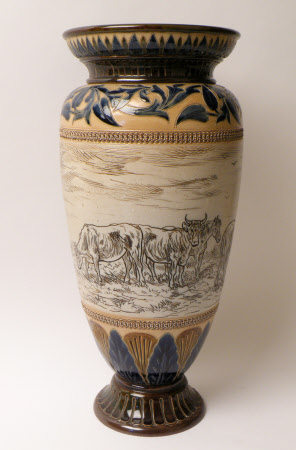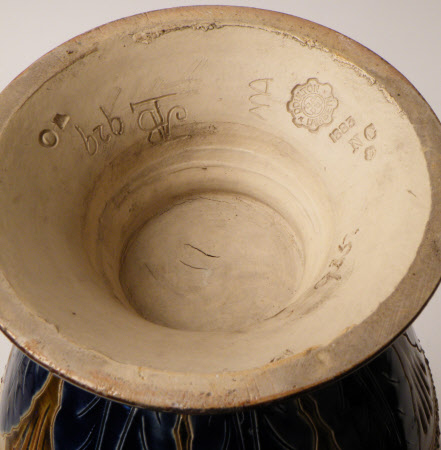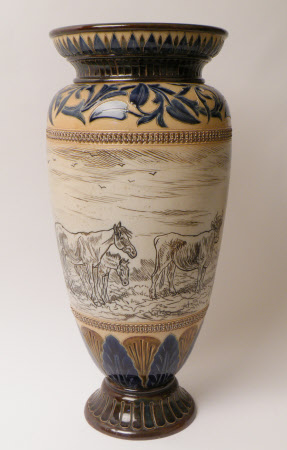Vase
Doulton and Co. (Ltd.)
Category
Ceramics
Date
1883
Materials
Ceramic
Measurements
400 mm (H)180 mm (Diameter)
Place of origin
Lambeth
Order this imageCollection
Standen House and Garden, West Sussex
NT 1213896
Caption
Hannah Bolton Barlow introduced giraffes, sheep, horses and ducks to the shelves and cabinets of many Victorian homes. She was one of the most successful and distinctive ceramic artists at Doulton & Co.’s Lambeth Art Studio in London. Barlow trained at the Lambeth School of Art and Design and briefly worked at Minton’s art pottery in Kensington before joining Doulton in 1871. Her vision, talent and tenacity played a major part in Doulton’s success. Barlow specialised in sgraffito, in which a design is incised directly into the clay surface, often through a light-coloured slip. Her mastery of this challenging technique was described by the writer C. Lewis Hind as ‘demanding a precision of touch rare, even among artists of distinction’. This is remarkable considering that in 1876 Barlow had lost the use of her (dominant) right hand. She wore hand splints for a few months and taught herself to use her left hand to execute her meticulous decoration. Although her right hand remained partly paralysed, she continued to pursue a long, successful career with the pottery. By the time she retired in 1913, she was head of the studio. A large number of women worked at Doulton, principally decorating pieces designed by the studio artists. Barlow taught herself to throw vessels on a potter’s wheel, so was a fully-fledged ceramic artist, designing forms as well as decoration. She is renowned for her spirited, economic depictions of animals, and took inspiration from the large menagerie of pets she kept at home, which included a tame fox and a Black Mountain sheep. A true collaboration, this vase was designed by Barlow and decorated with the assistance of her sister Lucy Anna Barlow (active 1882–5), as well as by Mary Aitken (active 1875–94) and Jenny F. Weekes (active from 1882). All three can be identified through their monograms, marked on the base.
Summary
Vase, stoneware, raised circular foot, ovoid form with slightly broader shoulder, shoulder and short, wide neck with ogee profile, designed and decorated by Hannah Bolton Barlow, assisted by Lucy Anna Barlow, Jenny F. Weekes and Mary Aiken, made by Royal Doulton, Lambeth, 1883; central frieze of cows and horses in sgraffito through a pale slip with grass to lower edge and stylised clouds to upper edge, moulded or incised flutes to foot, a border of stiff leaves and scallops to the lower body, rouletted bands beneath and above frieze, the shoulder with stylised, flowing leaves against a textured ground, pattern of stiff leaves around rim, the decoration picked out in blue, brown and orange coloured glazes.
Full description
Hannah Bolton Barlow (1851–1916) introduced giraffes, sheep, horses and ducks to the shelves and cabinets of many Victorian homes. She was one of the most successful and distinctive ceramic artists at Doulton & Co.’s Lambeth Art Studio in London. Barlow trained at the Lambeth School of Art and Design and briefly worked at Minton’s art pottery in Kensington before joining Doulton in 1871. Her vision, talent and tenacity played a major part in Doulton’s success. Barlow specialised in sgraffito, in which a design is incised directly into the clay surface, often through a light-coloured slip. Her mastery of this challenging technique was described by the writer C. Lewis Hind as ‘demanding a precision of touch rare, even among artists of distinction’. This is remarkable considering that in 1876 Barlow had lost the use of her (dominant) right hand. She wore hand splints for a few months and taught herself to use her left hand to execute her meticulous decoration. Although her right hand remained partly paralysed, she continued in a long, successful career with the pottery. By the time she retired in 1913, she was head of the studio. A large number of women worked at Doulton, principally decorating pieces designed by the studio artists. Barlow taught herself to throw vessels on a potter’s wheel, so was a fully-fledged ceramic artist designing forms as well as decoration. She is renowned for her spirited, economic depictions of animals, and kept a large menagerie of pets at home from which she took inspiration, including a tame fox and a Black Mountain sheep. A true collaboration, this vase was designed by Barlow and decorated with the assistance of her sister Lucy Anna Barlow (active 1882–5), as well as by Mary Aitken (active 1875–94) and Jenny F. Weekes (active from 1882). All three can be identified through the presence of their monograms, marked on the underside of the base.
Marks and inscriptions
Underside of base: DOULTON / LAMBETH / 1883 (impressed, factory mark, date) NC (impressed, probably denoting clay type) Underside of base: HB (incised, artist’s mark, Hannah Barlow) MA (incised, senior assistant’s mark, Mary Aiken) LAB (incised, artist’s mark, Lucy Anna Barlow) wO (impressed, Junior Assistant’s mark, Jenny F. Weekes) 933 / 929 (incised, meaning not known)
Makers and roles
Doulton and Co. (Ltd.) , manufacturer Hannah Barlow (1851 - 1916), artist Jenny F. Weekes (fl.1882), decorator Lucy Anna Barlow, decorator Mary Aitken (fl.1875 - 1894), decorator
References
Eyles and Irvine 2002: Desmond Eyles and Louise Irvine, The Doulton Lambeth Wares, Shepton Beauchamp: Richard Dennis 2002 Conroy, Rachel, Women Artists and Designers at the National Trust, 2025, pp. 134-5



